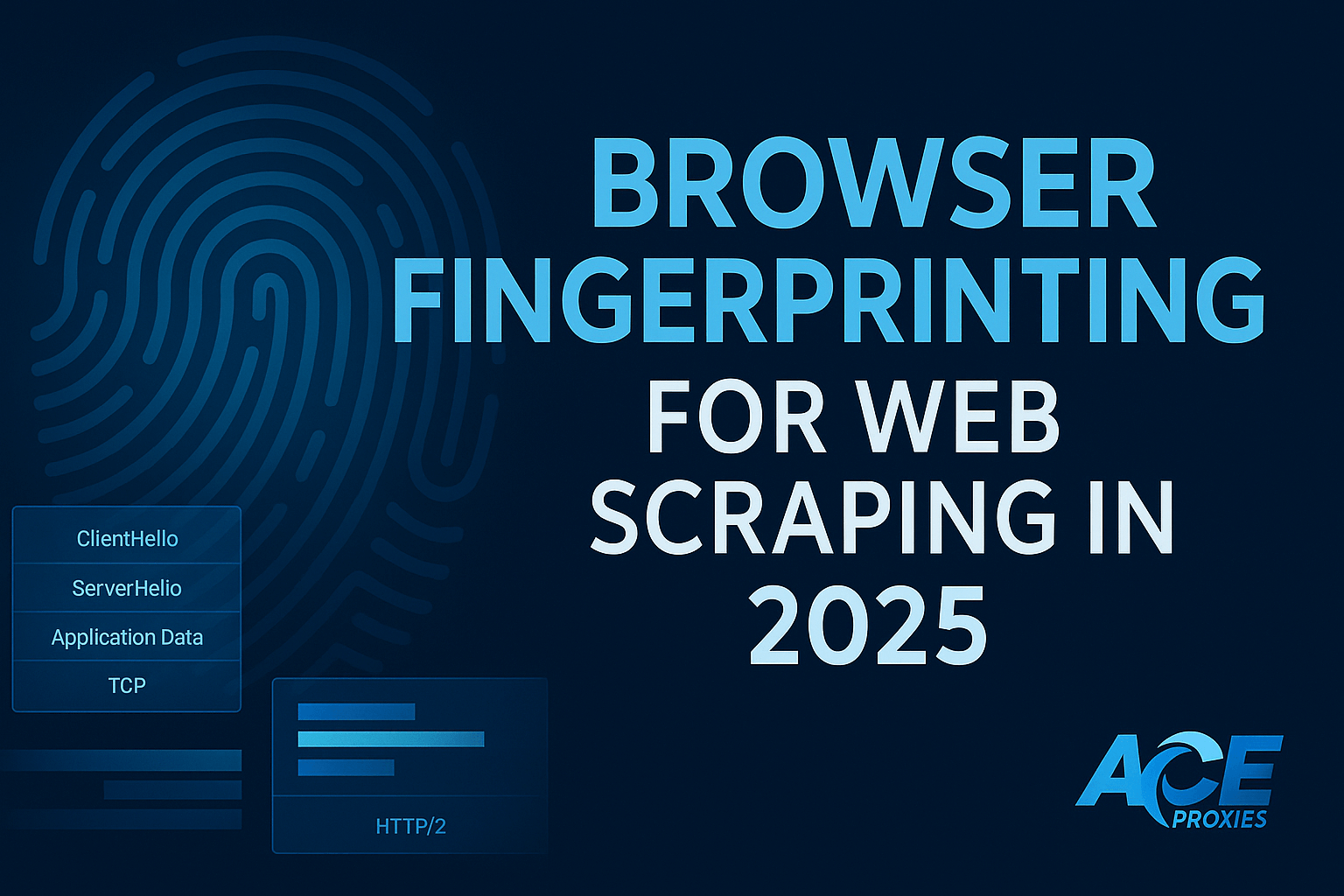Browser Fingerprinting for Web Scraping: The 2025 Playbook

If yesterday’s scraping debate was all about IP rotation, today’s fight is about identity. Modern anti bot systems profile how your client behaves on the wire and in the browser surface, not only where the request originates. To earn consistent access to public data, your client must look, talk, and pace itself like a real browser operated by a real person. This is the fingerprint era.
This playbook explains the fingerprint stack, shows how to build browser‑accurate clients, and maps proxy choices to compliance and risk. It stays practical, measurable, and aligned with business reality.
Why Fingerprinting Matters Now
- Detection moved upstream. Block lists and simple IP heuristics are easy to route around. Systems increasingly evaluate protocol details, header order, TLS handshakes, and session behavior.
- Browser surfaces evolved. Client hints, media capabilities, GPU details, fonts, and canvas outputs create a coherent “shape” of a device. Mismatched attributes raise flags.
- Compliance expectations rose. Responsible teams document purpose, respect policies where applicable, and avoid noisy patterns that resemble attacks. Good hygiene reduces risk and improves throughput.
The Fingerprint Stack: Three Layers to Align
Think of fingerprinting as three stacked layers. You win when all three tell the same story: a stable, human operated browser with a clear purpose.
1. Transport and Protocol
- TLS handshake identity. The ClientHello advertises cipher suites, extensions, and elliptic curves. Unique mixes produce recognizable fingerprints such as JA3.
- HTTP version and behavior. HTTP/2 adds entropy through pseudo header order and prioritization logic. HTTP/3 over QUIC introduces its own timing and packet patterns.
- Header order and casing. Some servers normalize, others do not. Inconsistent ordering across requests looks robotic.
2. Browser Surface
- User agent and client hints. Modern sites read UA plus sec‑ch‑ua values, platform, architecture, model, and full version lists. These must fit together.
- Locale, time zone, and language. Accept‑Language, time zone offset, and regional formats should align with IP geolocation and content language.
- Graphics and media. WebGL renderer, supported codecs, and canvas output form a consistent hardware story.
- WebDriver signals. Headless flags, missing APIs, and navigator.webdriver values are immediate tells when not handled correctly.
3. Session and Behavior
- Cookies and continuity. Humans carry state. Brand new sessions for every request look suspicious.
- Pacing and concurrency. Bursty, perfectly regular timing does not resemble people. Smooth pacing and realistic think time matter.
- Navigation flow. Real users load CSS, JS, and images. Pure JSON endpoint hammering is detectable on many stacks.
Browser‑Accurate in Practice: A Minimum Viable Blueprint
- Match a real browser profile.
Pick a specific Chrome or Firefox version and replicate its TLS, HTTP/2, and header patterns. Keep that selection consistent across requests in the same session. - Stabilize surface attributes.
Set user agent, client hints, language, time zone, screen size, and media capabilities to a coherent bundle. Avoid randomization that breaks realism. - Drive a genuine navigation flow.
Load pages as a human would. Fetch dependent resources. Execute required scripts. Respect robots.txt where applicable and operate at a courteous rate. - Persist session state.
Reuse cookies and local storage across related requests. Model realistic session lifetimes and logouts. - Separate environments by use case.
One profile per task family. Mixing many behaviors under a single identity increases detection risk.
TLS and JA3: Getting the Handshake Right
- Choose a browser‑aligned TLS stack. Your TLS ClientHello should reflect a real version’s cipher suite order, extensions, and ALPN settings.
- Keep the story consistent. If your HTTP headers and TLS handshake suggest different clients, detection systems notice.
- Avoid overfitting. Matching a popular browser profile is enough. Constant micro‑tweaks create drift and regressions.
Quick wins
- Prefer clients that can impersonate real browser TLS profiles.
- Verify that HTTP/2 is enabled where appropriate, with realistic prioritization.
HTTP/2 and HTTP/3: Protocol Behavior That Sells the Story
- Pseudo header order. The order of :method, :path, :scheme, and :authority should mirror a real browser’s defaults.
- Prioritization and concurrency. Browsers stream assets with characteristic patterns. If every request is serialized, or all requests flood at once, that is suspicious.
- HTTP/3 considerations. If the target supports QUIC and your stack claims a browser that prefers it, align on that path or make your client story consistent with HTTP/2 only.
Checklist
- Confirm HTTP version negotiation is stable.
- Keep connection reuse realistic.
- Handle server push deprecations gracefully.
The Browser Surface: Where Most Bots Slip
- User agent plus client hints. Do not change UA mid session. Pair UA with coherent sec‑ch‑ua values.
- Language and time. Match Accept‑Language with the exit location and keep time zone consistent.
- Graphics stack. Ensure WebGL vendor and renderer match the OS and GPU class implied by the user agent.
- Media and codecs. Many sites verify codec support for streaming features.
- Navigator and permissions. Avoid missing or partial APIs that scream automation.
Pro tip
Pick two or three battle‑tested device profiles and harden them. Rotate between them by cohort, not by request.
Session Realism: The Human Signal
- Carry state forward. Persist cookies and storage across visits.
- Respect pacing. Use queuing to avoid bursts. Add natural think time.
- Navigate like a person. A page view should usually precede API calls.
- Retry with patience. Exponential backoff beats rapid fire retries.
Proxy Strategy That Matches Your Identity
- Datacenter Proxies
Ideal for permitted public data at scale. You get predictable performance and transparent origin. Use them when your compliance position is clear and you want repeatable throughput. Link this section to your Datacenter Proxies page. - Rotating Residential Proxies
Best for geo specific public data and rate sensitive targets. Rotation spreads load and reduces hot spots from a single exit. Use sparingly and politely. Link to Rotating Residential Proxies. - Static Residential (ISP) Proxies
Great for long lived research and partnership workflows that benefit from a stable reputation over time. Link to Static Residential (ISP) Proxies.
Map each choice to your risk model, not just to block rates. The right proxy is the one that fits your legal basis, business purpose, and fingerprint story.
Measurement: Prove It Works
Track signals that indicate fingerprint mismatch and session stress.
- Challenge and CAPTCHA rate by route and by device profile.
- Session lifetime before a forced logout or challenge.
- Headless vs headful delta in success rates.
- Retry reasons categorized into transport errors, timeouts, and policy responses.
- Latency distribution and tail behavior under load.
Adopt a test matrix. Change one variable at a time: TLS profile, header order, language, pacing. Keep detailed runbooks so fixes are reproducible.
Tooling That Helps, Tactics With Restraint
- Modern browsers and drivers . Keep Chrome or Firefox versions current and aligned with your profiles.
- HTTP clients that support browser‑like TLS . Use clients capable of emitting realistic ClientHello and HTTP/2 behavior.
- Playwright or Puppeteer hardening. Hide obvious automation tells, but do not chase every micro signal.
- Configuration as code. Declare device profiles, language sets, and pacing in version control.
- Observability. Capture HAR files, TLS info, and server responses for debugging. Redact sensitive data.
Use these tools to remove accidental tells. Let ethics, consent, and policy set the ceiling on collection.
Compliance and Ethics: Lower Risk, Build Trust
- Document purpose. Explain why you are collecting the data and how it benefits users or the business.
- Respect policies where applicable. Robots.txt, rate guidance, and published access rules exist for a reason.
- Minimize personal data. Exclude PII unless you have a clearly documented basis.
- Offer contact paths. A real User Agent string and an abuse contact de escalate issues quickly.
- Keep a deletion practice. If you receive a takedown request that is valid, act promptly.
Your strongest technical defense is an ethical posture supported by clear documentation. This reduces both legal risk and operational friction.
Incident Response: When Blocks Happen
Have a short, written plan so teams do not improvise under pressure.
- Freeze changes and capture evidence. HAR traces, TLS details, and response bodies.
- Classify the block. Transport failure, rate limiting, session policy, or full denial.
- Roll back the last change to TLS or HTTP behavior if the timing aligns.
- Reduce concurrency and rotate to a known good device profile.
- Pause and review compliance posture before escalating technical force.
- Communicate with stakeholders and, when appropriate, with the site owner.
FAQ: Fast Answers for Common Questions
Q: Is matching JA3 enough?
No. JA3 alignment helps, but HTTP/2 behavior, header order, and browser surface must also agree with your claimed client.
Q: Do headless browsers always get flagged?
Not always. Many signals can be made consistent. What matters is whether the total fingerprint looks like a stable, human operated browser.
Q: How often should we update device profiles?
Quarterly is a good baseline. Update sooner if your telemetry shows rising challenge rates or after major browser releases that change defaults.
Q: Can proxies alone solve blocks?
Proxies handle origin and geography. Fingerprints handle identity. You usually need both aligned with compliance.
Q: Should we randomize everything to be unique?
No. Real users are not random. Pick a few realistic profiles and be consistent within a session and a cohort.
Glossary
- Browser fingerprinting: Collecting many client attributes to identify or classify a device.
- JA3: A hash summarizing TLS ClientHello parameters.
- HTTP/2 fingerprint: Identity derived from header order, prioritization, and framing behavior.
- Client hints: Headers that reveal browser brand, full version, platform, and model.
- Session realism: Carrying state and pacing requests to resemble human use.
Your Next Move
Fingerprint accuracy is not about trickery. It is about building a coherent, respectful identity that reflects a real browser and a legitimate purpose. Map your goals to the right proxies, harden your client’s fingerprint, and measure outcomes. That is how you scale responsibly.
Unsure which proxy fits your use case? Read our Proxy Playbook. Scrape with Confidence